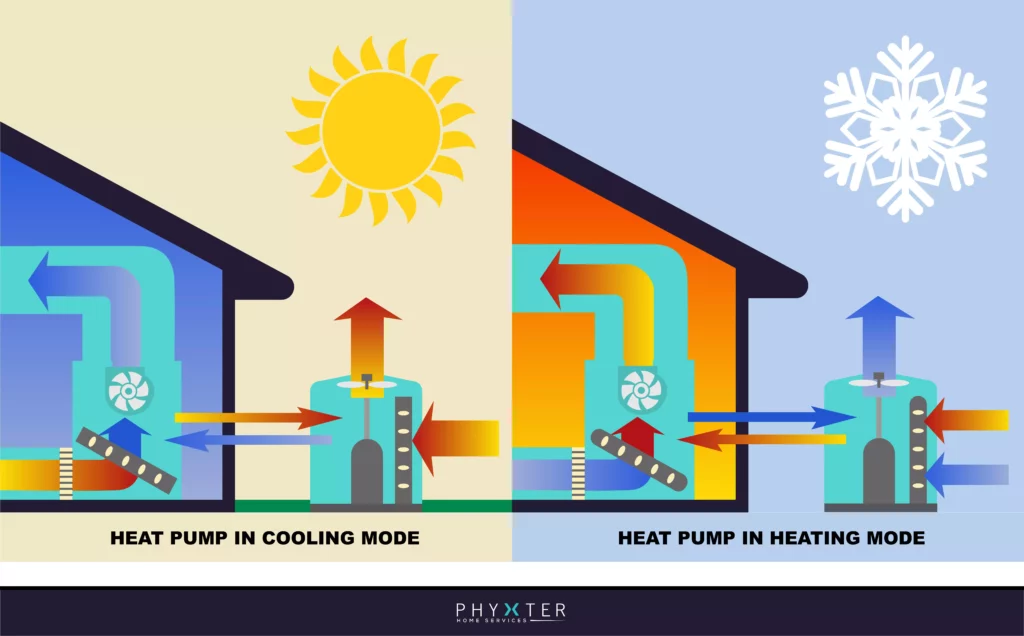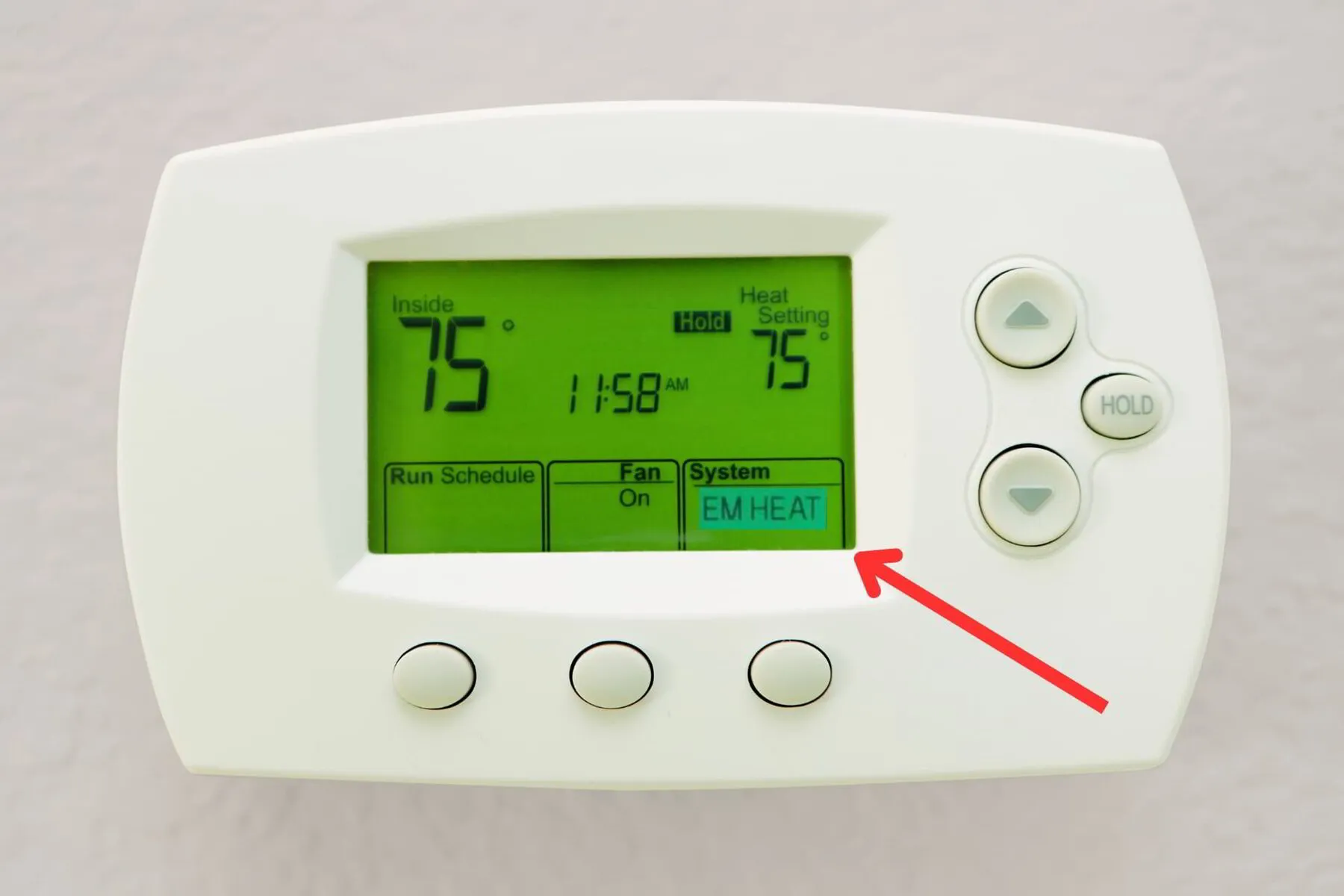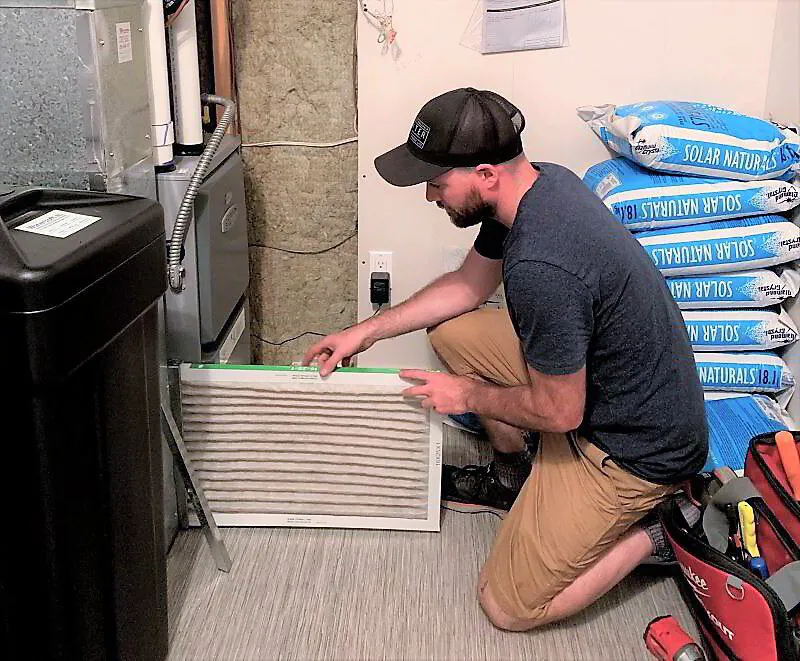Heat pumps are a great way to keep your home comfortable throughout the year, but when extreme temperatures hit, it can be difficult for a heating system to keep up. If this happens, your heat pump may switch to emergency heat mode. But when does this occur?
In this article, we will discuss when a heat pump switches to emergency heat and answer any questions you might have about the process.
📘 Key Takeaways
- Emergency Heat Activation: A heat pump switches to emergency heat during extremely cold temperatures, typically below freezing, when it cannot sufficiently heat the home.
- Auxiliary Heating Elements: Auxiliary heat uses secondary heating systems like electric resistance heating or a natural gas furnace to maintain a comfortable temperature.
- Spotting the Signs: Indications that a heat pump is in emergency heat mode include increased utility bills, constant running of the backup system, reduced airflow, and no change in room temperature.
- Prevention Strategies: Regular maintenance, including cleaning and replacing air filters and ductwork, can help prevent a heat pump from switching to emergency heat.
- Upgrade for Efficiency: Investing in a newer, more efficient heat pump can increase overall performance and reduce the likelihood of emergency heat activation.
🔥 What Is A Heat Pump?
Image Courtesy of Phyxter Home Services
A heat pump, which serves as both a heater and a reversible air conditioner, operates by extracting heat from the outside air to warm your home, functioning effectively in moderately cold conditions.
When the temperature drops further, auxiliary heat (aux heat) activates to support the heat pump, ensuring efficient heating. In the event of a heat pump failure or malfunction, particularly in extreme cold weather, the system shifts to emergency heat mode.
This backup mode bypasses the regular operation of the heat pump, relying instead on an alternative heating source to maintain warmth in your home.
📘 Related Reading: HVAC Insights: How Does a Heat Pump Work in Winter?
🔥 What is Emergency Heat?
Understanding the concept of emergency heat is crucial for efficiently managing your heat pump system during the coldest days of the year.
Emergency heat, often labeled as "EM Heat" on your thermostat, is a specific setting designed for use in certain situations.
Emergency Heat Explained
Emergency heat is the secondary heating system that your heat pump switches to when it can no longer efficiently extract heat from the outside air due to extremely cold weather. This mode is activated when the heat pump malfunctions or when the heat pump stops working.
When to Use Emergency Heat
This setting should be used sparingly and only in specific circumstances:
- Extreme Cold: When temperatures drop so low, the heat pump can no longer heat your home effectively.
- Heat Pump Malfunction: In cases where the heat pump is not functioning correctly, emergency heat can provide a temporary heating solution.
Impact on Efficiency and Cost
Relying on emergency heat can lead to higher energy consumption and increased utility bills, as it is generally less efficient than the regular operation of the heat pump supplemented by aux heat.
Switching back to normal heat pump operation is important when extreme conditions subside, or the heat pump is repaired.
Key Takeaway
Emergency heat is crucial for ensuring warmth in your home during extreme weather conditions or equipment malfunctions. However, its efficient use is key to maintaining energy costs and prolonging the life of your heating system.
🔥 The Role of Auxiliary Heat in Your Heat Pump System
In the context of heat pump operation, it's important to distinguish the specific role of aux heat, especially in relation to emergency heat.
This section aims to clarify this distinction, ensuring a complete understanding of your heating system's functionality.
Auxiliary Heat: A Complementary System
Auxiliary heat, often integrated into heat pump systems, is a complementary heat source. It's designed to assist the heat pump when the external temperature is too low for the heat pump to heat your home efficiently but not so low as to necessitate the switch to emergency heat.
How Auxiliary Heat Works
The aux heat automatically activates when the heat pump loses efficiency due to moderately cold temperatures. This system, typically comprising electric resistance heaters in the form of an electric heat strip or a secondary gas or electric furnace, provides the additional warmth needed to maintain your desired indoor temperature.
Differentiating Auxiliary Heat from Emergency Heat
- Activation: Auxiliary heat activates automatically, providing supplemental heating alongside the heat pump. In contrast, emergency heat is a manual setting used when the heat pump cannot function effectively.
- Usage Scenarios: Auxiliary heat is ideal for regular cold days where just a bit more warmth is needed. Emergency heat is reserved for extreme situations, such as system malfunctions or unusually severe cold spells.
Efficient Use of Auxiliary Heat
Understanding when auxiliary heat operates can help you manage your system more efficiently. Regular maintenance checks ensure that both the heat pump and auxiliary system function optimally, preventing unnecessary switches to the less efficient emergency heat.
By recognizing the role of auxiliary heat and its automatic activation, you can better monitor your heat pump's performance and energy usage. This awareness is key to maintaining an efficient, cost-effective heating system throughout the colder months.
🔥 What Affects When a Heat Pump Uses Emergency Heat
❄️ Outdoor Temperature
Heat pumps are designed to work most efficiently in mild temperatures, and as the outdoor temperature drops, the heat pump's ability to extract heat from the outside air also decreases.
At a certain point, usually between 20-30°F, the heat pump will be unable to extract enough heat from the outside air to maintain the desired indoor temperature
At this point, the emergency heating source will be activated to supplement the heat pump's output.
❄️ Temperature Setpoint
The temperature set point is your desired temperature on your heat pump thermostat.
When the heat pump runs normally, it will try to maintain this temperature set point by extracting heat from the outside air and circulating it inside the home.
However, if the outdoor temperature is too low or the heat pump is not functioning properly, the heat pump may not be able to maintain the set point.
In such cases, the emergency heat setting will be activated to supplement the heat pump's output and increase the temperature to the desired set point.
You will know as the emergency heat light will be shown on the thermostat screen.
Users can adjust their thermostat to a lower temperature set point. This will reduce the amount of heat required to reach the set temperature and decrease the chances of auxiliary heat being activated.
However, it is essential to remember that lower temperatures might not be comfortable during cold days and can be a trade-off.
❄️ Age and Maintenance
The age and maintenance of your heat pump are important factors in determining when emergency heat mode will be activated.
Over time, the internal components can become worn or damaged due to wear and tear, making it less efficient at heating your home or switching to emergency mode to keep temperatures comfortable.
So, regular maintenance is essential for keeping it working efficiently.
❄️ Blockages or Damage to the Air Filter or Ductwork
Blockages or damage to the air filter or ductwork can also cause your heat pump to switch to the secondary heat source.
If the air filter becomes clogged or damaged, the airflow to the heat pump can be restricted, which can decrease the heat pump's ability to extract heat from the outside air.
Similarly, if the ductwork becomes blocked or damaged, the air that is circulating through the home can also be restricted.
🔥 Signs that a Heat Pump is Switching to Emergency Heat
Several signs indicate that a heat pump may be switching to emergency heat.
These include:
Increase in Utility Bills:
If your heating system frequently switches to emergency heat, it can result in higher energy usage, which can cause an increase in utility bills.
Backup Heating System is Constantly Running:
When the emergency heat source is activated, it will constantly run until the heat pump can maintain the desired temperature set point. If the backup heat source is constantly running, it may also indicate that the heat pump is malfunctioning.
Reduced Airflow:
When the heat pump is functioning properly, there should be a consistent flow of warm air from the vents. If the airflow is reduced, it may be due to blockages or damage to the air filter or ductwork.
No Change in Room Temperature During Operation:
If the heat pump is running, but the room temperature is not changing, it may be a sign that the heat pump is not functioning properly or is unable to extract enough heat from the outside air.
In such cases, the secondary heating source will be activated to supplement the heat pump's output.
By paying attention to these signs, homeowners can identify when their heat pump may be switching to supplemental heat and take steps to fix the problem before it becomes a bigger and more costly problem.
🔥 Signs that a Heat Pump is Switching to Emergency Heat
To prevent a heat pump from switching to EM heat, several steps can be taken:
Schedule Regular Maintenance and Cleaning:
This includes tasks such as cleaning the outdoor coil, checking the refrigerant level, and lubricating the moving parts. Check the manufacturer's manual for more information on service intervals.
Replacement of Air Filters and Cleaning of Ductwork:
Dirty or clogged air filters can reduce airflow to the heat pump, decreasing its efficiency. Similarly, dirty ductwork can have the same effect.
Regularly replacing the air filter and inspecting and cleaning the ductwork ensures good airflow and efficiency will be improved.
Improve Your Home Energy Efficiency With Insulation:
Insulating the home can help reduce the heat lost through the walls, floors, and ceilings. This can help the heat pump to maintain the desired temperature set point, even in lower outdoor temperatures.
Properly insulating your home can reduce energy usage and costs, reducing the chances of the HVAC system switching to emergency heat mode.
Upgrade Your Heat Pump:
As heat pumps age, they can lose efficiency and require more repairs. Once those repair costs reach approximately 50% of a replacement, it's time to consider it.
With today's technology, homeowners can be assured that their heat pump is running as efficiently as possible by upgrading to a newer, more efficient model.
By following the above steps, homeowners can reduce the likelihood of their heat pump switching to emergency heat more often than it should.
It is always important to consult the manual, get expert advice, and ensure that the maintenance is done by qualified professionals.
Finally!
It’s important to be aware of the factors that can cause a heat pump to switch to emergency heat and how to prevent emergency heating from occurring.
By understanding when and why emergency heat is needed, you can take steps like regular maintenance and cleaning, replacing air filters, or insulation upgrades to keep your system running efficiently without relying on emergency mode too often.
If you suspect an issue with your system, it's always best practice to contact a professional HVAC technician.
They will be able to diagnose any potential problems and get your primary heating system back up and running smoothly and efficiently again.
Want to learn more about your home's HVAC system? Check out our other HVAC articles!
Scott Harding
Scott is the main author of DIY Home Comfort. He's also an experienced HVAC technician that enjoys home renovation and spending time with his family. You can find out more about him here.
Frequently Asked Questions
How Can I Tell if My Heat Pump is in Emergency Heat Mode?
Identify emergency heat mode by checking the thermostat for an indicator light or message. You may also notice the outdoor unit is not running, as emergency heat typically bypasses the heat pump's standard operation.
What Maintenance Can Prevent Unnecessary Switching to Emergency Heat?
Regular maintenance, such as cleaning filters, checking refrigerant levels, and ensuring unobstructed airflow, can prevent your heat pump from unnecessarily switching to emergency heat.
Can I Manually Activate Emergency Heat, and How?
Yes, you can manually activate emergency heat via your thermostat. Look for a setting labeled 'Emergency' or 'EM Heat' and switch to it as needed.
Does the Use of Emergency Heat Affect the Lifespan of My Heat Pump?
Prolonged use of emergency heat can strain the system, potentially affecting the lifespan of your heat pump. It's designed for short-term use during extreme conditions or system malfunctions.
Are There Any Signs That Indicate My Heat Pump Might Soon Rely on Emergency Heat?
Signs include frequent cycling on and off, inability to reach set temperatures, and unusual noises. These may indicate inefficiencies that could lead to reliance on emergency heat.







